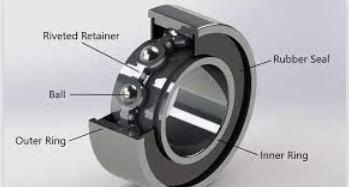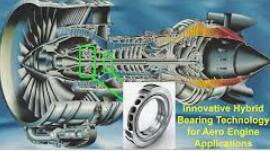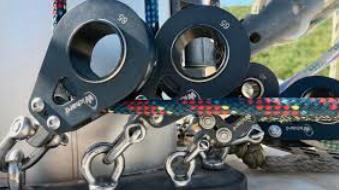Bearings in Extreme Environments
Discover how bearings perform in extreme environments. Learn about their durability, functionality, and applications in challenging conditions.
Bearings in extreme environments are engineered to withstand harsh conditions such as high temperatures, corrosive environments, heavy loads, and more.
These specialized bearings are designed to provide reliable performance and longevity in challenging settings where standard bearings may fail.
Bearings in extreme environments are made from robust materials such as stainless steel, ceramic,
or high-temperature alloys to withstand temperature extremes, corrosive chemicals, and abrasive particles.
They feature advanced sealing technologies to prevent contamination and maintain lubrication.
Whether it's in aerospace, automotive, marine, or industrial applications,
understanding how bearings function in extreme environments is crucial for optimizing machinery and ensuring operational efficiency.
Overview of types of bearings used in extreme environments

-High-Temperature Bearings are engineered to operate in extreme heat, such as in furnaces, kilns, and engines.
They are made from heat-resistant materials like ceramic or special alloys to maintain structural integrity and lubrication at high temperatures.
-Corrosion-Resistant Bearings are designed to resist corrosive environments, such as chemical processing plants or offshore installations.
They are often made from stainless steel or other corrosion-resistant materials,
with specialized coatings or seals to protect against chemicals, moisture, and contaminants.
-Heavy-Duty Bearings are built to handle heavy loads and intense forces, commonly found in industries like mining, construction, or heavy machinery.
-Vacuum-Compatible Bearings are used in applications involving vacuum or space environments.
-Magnetic bearings utilize magnetic forces to support rotating shafts without physical contact, eliminating the need for lubrication and reducing wear.
-Radiation-Resistant Bearings are used in nuclear power plants, space exploration, or medical equipment.
Bearings in Aerospace Applications

Role of bearings in aerospace technology
In aircraft, bearings are used in engines, landing gear, control surfaces, and auxiliary systems.
They enable the rotation of shafts, provide support for moving parts, and reduce friction and wear.
High-precision and lightweight bearings are essential for achieving optimal performance and fuel efficiency in jet engines, where they support the turbine, compressor, and auxiliary components.
In landing gear systems, bearings facilitate the smooth retraction and extension of landing gear, absorbing shocks during landing and takeoff.
Bearings contribute to the precise movement and control of flight surfaces, such as ailerons, elevators, and rudders.
They ensure smooth operation, allowing pilots to maneuver the aircraft with precision.
Challenges of designing and manufacturing bearings for space environments
The vacuum of space requires bearings to operate without the presence of air or lubricants that may evaporate or outgas under low-pressure conditions.
Special materials and lubrication techniques are needed to ensure long-term performance and prevent contamination.
Space environments subject bearings to extreme temperature variations, ranging from extreme cold to intense heat generated by friction during operation.
Bearings must be designed to withstand these temperature extremes without compromising performance or structural integrity.
The presence of cosmic radiation in space can adversely affect bearing materials, causing degradation and potential failure over time.
Radiation-resistant materials and shielding measures must be incorporated into the design to ensure the bearings' durability and reliability.
Weight and size restrictions in space missions require bearings to be lightweight and compact without sacrificing performance.
Examples of applications, such as satellite systems and rovers
In satellite systems, bearings are used in various components such as solar panels, antenna systems, and reaction wheels.
They allow the smooth rotation and positioning of solar panels to capture maximum sunlight for power generation.
Bearings also facilitate the movement of antennas for communication and data transmission.
Reaction wheels, which control the satellite's orientation and stability, rely on high-precision bearings to provide precise and controlled rotational movement.
In the context of rovers, bearings are essential for the mobility and maneuverability of these vehicles on extraterrestrial surfaces.
They are used in wheel assemblies, suspension systems, and steering mechanisms, enabling the rovers to traverse diverse terrains and carry out scientific exploration missions.
Bearings in rover wheels withstand the harsh conditions of uneven and rocky surfaces while maintaining smooth rotation and minimizing friction.
Bearings in Marine Applications

Role of bearings in marine technology
Bearings play a vital role in marine technology, supporting various systems and equipment onboard ships and other maritime vessels.
In marine propulsion systems, bearings are utilized in the main engine shafts, intermediate shafts, and propeller shafts.
They provide the necessary support and allow the rotation of these shafts, ensuring efficient power transmission from the engine to the propeller.
Challenges of designing and manufacturing bearings for underwater environments
Bearings used underwater must be resistant to corrosion, as prolonged exposure to seawater can cause degradation and premature failure.
Bearings must be designed to withstand the immense pressure exerted by the water at different depths,
ensuring their structural integrity and preventing damage or failure.
Underwater bearings face challenges related to lubrication.
Traditional lubricants may not perform well in water, leading to inadequate lubrication and increased friction.
Maintaining effective sealing mechanisms is crucial in underwater bearings to prevent water ingress and protect internal components.
Examples of applications, such as subsea equipment and offshore wind turbines
In subsea equipment, such as underwater robots (ROVs), bearings are used in the joints and actuators that enable precise movement and manipulation in the deep-sea environment.
In the context of offshore wind turbines, bearings are crucial components in the turbine's main shaft, gearbox, and yaw systems.
Advances in Bearing Materials Science and Manufacturing Techniques
Developments in materials science for extreme environments
Ceramic and ceramic hybrids, corrosion-resistant alloys,
such as stainless steel and nickel-based alloys find applications in bearings used in marine environments,
chemical processing plants, and offshore oil and gas platforms.
Moreover, advancements in composite materials have led to the development of fiber-reinforced polymers,
providing a combination of high strength, low weight, and corrosion resistance,
making them ideal for bearings in lightweight applications such as aerospace and marine industries.
The use of self-lubricating materials, such as polymers with embedded solid lubricants,
has been explored to reduce friction and wear in bearings, especially in applications where traditional lubrication is challenging or impractical.
Innovative manufacturing techniques, such as additive manufacturing and cryogenic machining
Additive manufacturing, also known as 3D printing, has gained traction in bearing production.
It allows for the creation of complex geometries and customized designs that were previously challenging or impossible to achieve through traditional manufacturing methods.
With additive manufacturing, bearings can be produced with optimized internal structures, reduced weight, and improved load-carrying capacities.
Cryogenic machining offers advantages such as increased tool life, reduced cutting forces, and improved surface finish.
When applied to bearing manufacturing, cryogenic machining minimizes thermal stresses and distortion, resulting in improved dimensional accuracy and better surface integrity.
Examples of how these advancements are driving innovation in bearing design and performance
In terms of bearing design, additive manufacturing enables the creation of intricate internal geometries and complex structures that were previously unattainable with traditional manufacturing methods.
This has led to the development of lightweight bearings with optimized load-carrying capabilities and improved stiffness-to-weight ratios.
The ability to customize bearings based on specific application requirements has also been made possible, allowing for tailored solutions that maximize performance and efficiency.
On the other hand, cryogenic machining has had a significant impact on the precision and quality of bearing surfaces.
The use of extremely low temperatures during machining reduces the generation of heat and minimizes thermal stresses, resulting in improved dimensional accuracy and surface finish.
This enhanced precision translates into bearings with smoother operation, reduced friction, and increased service life.
Case Studies
Examples of successful bearing applications in extreme environments
-High-Temperature Bearings are used in gas turbines for power generation,
maintaining performance and reliability in extreme heat conditions.
-Deep-Sea Bearings are applied in underwater ROVs, enabling precise movement and manipulation in the challenging conditions of deep-sea exploration.
-Space Bearings utilized in satellites and space exploration vehicles, withstanding vacuum,
radiation, and temperature extremes for reliable operation in outer space.
-Offshore Wind Turbine Bearings are supporting the rotation and power transmission in offshore wind turbines,
enduring corrosive saltwater and extreme weather conditions.
-Nuclear Power Plant Bearings are withstanding radiation exposure and operate reliably in nuclear power plants for safe and efficient electricity generation.
Lessons learned from past failures or challenges
Lessons learned from past failures or challenges of bearings include the importance of proper lubrication, regular maintenance,
and selecting materials suitable for specific operating conditions.
Inadequate lubrication can lead to increased friction, wear, and premature failure.
Regular maintenance and inspection help detect potential issues and prevent catastrophic failures.
Choosing materials with appropriate corrosion resistance, load-bearing capacity,
and temperature tolerance is crucial to ensure the long-term reliability and performance of bearings.
Future directions and opportunities for further research
Future directions and opportunities for further research of bearings include exploring advanced materials,
such as nanocomposites and self-healing materials, optimizing lubrication techniques,
developing smart and sensor-integrated bearings, and investigating sustainable manufacturing processes to improve performance,
durability, and efficiency.
Conclusion
Bearings in extreme environments play a vital role in various industries, from aerospace to underwater exploration.
Advances in materials science, manufacturing techniques, and design innovations continue to drive the development of bearings that withstand harsh conditions,
ensuring reliable performance and pushing the boundaries of what is possible.





